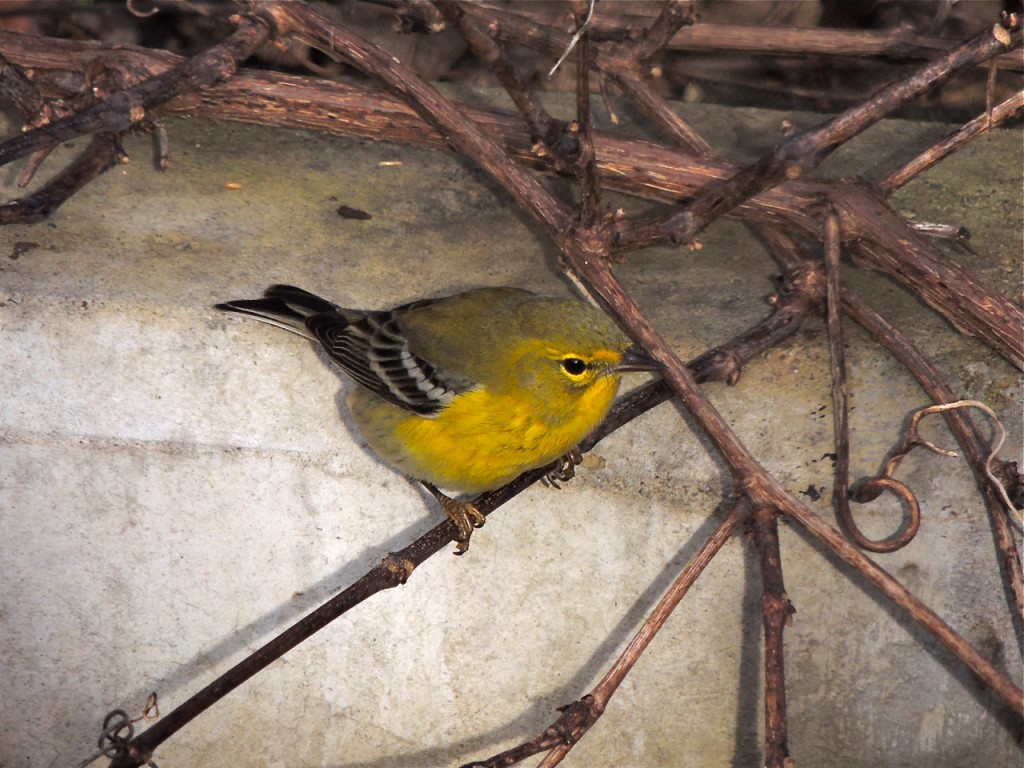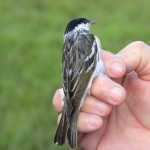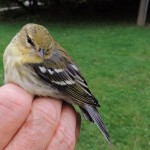1 October 2014. Cayuga ON. Our long stretch of Indian Summer was shaken up with a stormy front passing through. It’s still warm but much cooler weather is imminent. The change has apparently reminded migrant birds that it’s time to stop dallying and to get a move on. It produced some interesting birds at the bird observatory.
I did the daily census, which was rather quiet, the number of species (21) was okay but numbers of individuals were low. The highlight of the census may have been a patrolling Belted Kingfisher working the far shore of the river. I was also grateful for a heard but unseen Common Yellowthroat who started singing its signature “witchety–witchety” song for the benefit of a visitor, just as I had finished describing it to her.
Birds of the Day came right at the end when we captured and banded two Blackpoll Warblers. Blackpoll Warblers can be tricky to identify in fall, the conspicuous black and white dress of spring, moults to a rather non-descript, easily confusable, olive green and muddy white with wingbars. Here are a couple of photos to illustrate the contrast.
The Blackpolls weren’t the only warblers today, we’d also seen Black-throated Green and Black-throated Blues, an American Redstart and a Pine Warbler. A little more about the Pine and the Blackpoll Warblers is justified because both generated a lot of discussion and interest.
The Pine Warbler because it took a while to identify, perhaps because we don’t see them often. They are, as their name suggests, a bird that favours pines, and the observatory is surrounded by hardwood forest. Below is a photo of another Pine Warbler taken a year ago, probably a mature male showing all field marks. The one we handled today was a young female with absolutely none of the bright yellow about it. It was a very drab muted olive-yellow below, its back grayish brown, the wing-bars very subdued, the partial eye-ring whitish and that little line above and between the beak and the eye almost invisible. Even Rick, who knows his birds better than almost anyone I’ve met, was hard pushed to identify it, spending some time scouring the pages of the Peterson Field Guide to Warblers looking for a likely match.

Blackpoll Warblers are wonderful little birds with one of the nature’s best migration stories. They breed across the northern coniferous forests of Alaska and Canada where the dense forests give way to tundra; a very long way north of us. But their fall migration is an epic journey in which the mortality rate must surely be very high. After making the mind-bendingly long trip from the tundra (from as far as Alaska remember) to the softness of America’s eastern seaboard, they launch themselves south and east, out over the Atlantic. They fly endlessly, navigating by systems that we can barely comprehend, until they reach the north-east trade winds which blow them back to a landfall in Puerto Rico, the Lesser Antilles, or northern South America; a journey of up to 3,000 Km., or as much as ninety hours, non-stop. To survive they need a lot of luck and all of the gods on their side, they must: avoid predators like domestic cats, Merlins or Sharp-shinned Hawks: be in top physical condition; and have sufficient fuel on board to carry them on that open Atlantic stage for the best part of four days. (I don’t know what you were doing four days ago, but for me, the idea of a non-stop, foodless trot since Sunday’s Blue-headed Vireo encounter, (my previous post), is incomprehensible.)
The two Blackpoll Warblers we banded today were carrying large amounts of fat as fuel for the ultra marathon ahead. They each weighed about 22 g, double a more typical spring and summer weight of 10 to 12 g. Birds store fat in the avian equivalent of the hollow you and I have between our collarbones (just below our throat), under their wings (our armpits) and lower belly; all of these areas were bulging full. They even felt plump in the hand as we banded and measured them. Once banded, measured, aged, sexed and weighed we released them with our fervent best wishes for a safe passage.

